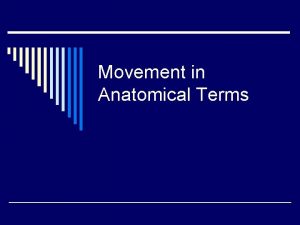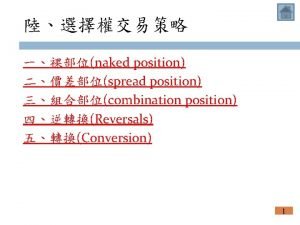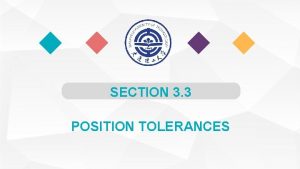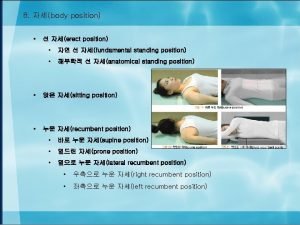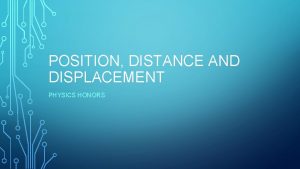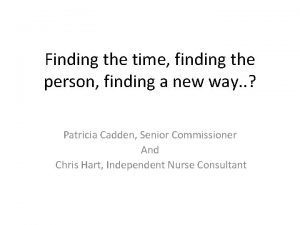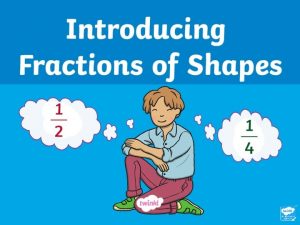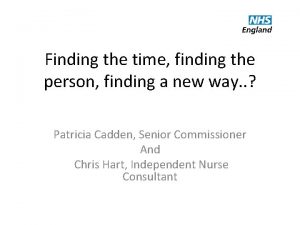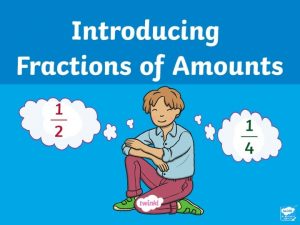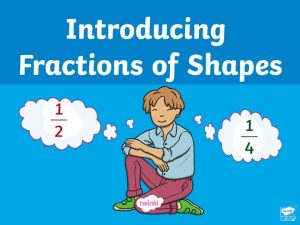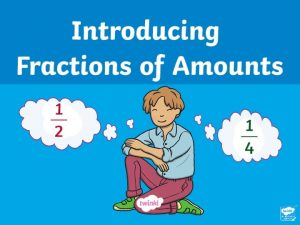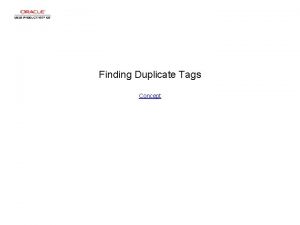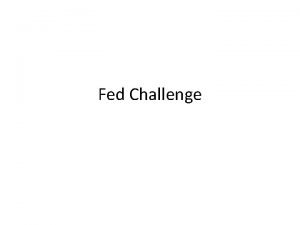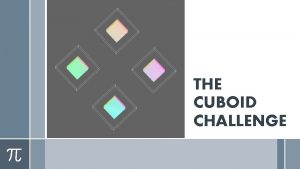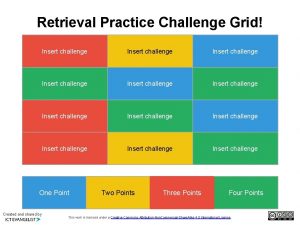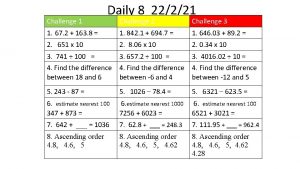The Challenge of Finding Your Position in a

































- Slides: 33

The Challenge of Finding Your Position in a World Hostile to Radio Navigation Prof. dr. Durk van Willigen Reelektronika, Netherlands ILA 2003 Boulder, Colorado, USA, 3 -7 November 2003 Durk van Willigen reelektronika 1

Overwhelming GPS Success • • GPS revolutionised navigation GPS is embraced by its users GPS never fails Emerging worries on GPS Concern PCCIP Volpe Report US leads rethinking on vulnerability GPS From sole-means dissimilar systems Durk van Willigen reelektronika 2

Vulnerability a today’s Issue? • Yes, because society never relied so strongly on a single source of navigation and time before the GPS era • Yes, because never before the bad guys were able to disable our core navigation and time sources so easily and untraceably, and over such large areas • Yes, because many do not recognize this flaw and do not take timely precautions Durk van Willigen reelektronika 3

User’s Attitude • We have GPS, it performs excellent, it is extremely cost-effective, so why worry? • Question: Imagine living without fire fighters, vaccination, life-boats, police, dikes, … • We have them all, we generously pay for it, but we are convinced that we will never need them • Fortunately, we don’t need such precautions for GPS or GLONASS or Galileo because these systems are perfect !! Durk van Willigen reelektronika 4

Why Galileo next to GPS? • Because Europe is an industrial high-tech world player • Europe aims to be successful in GNSS technology just as it is with Airbus, ESA, Concorde, TGV, GSM, Bach, Rembrandt, …. • But like the US, Europe prefers to be autonomous in respect of navigation and timing • Europe is keen to make profit with its own Galileo business Durk van Willigen reelektronika 5

US-European Navigation Co-operation? • Users will like Galileo as it doubles the number of navigation satellites improving availability in city areas • Professional navigators think Galileo may reduce the single-point-failure effects in the technical and control segments • US military highly dislikes Galileo’s PRS as it makes GPS’ M-code less effective • PRS = Public Restricted Services Durk van Willigen reelektronika 6

PRS versus M-code • The US officially and repeatedly stated that it will deny all non-US satellite navigation services if US national security requires so • Europe would like to prevent that • Europe might also deny GPS to many other countries if needed • Question from a simple not involved observer: – Does the US rule GNSS like the UK ruled the waves? – Are the US and Europe each others hostages? • In all public statements these issues are not mentioned of course (ION-GPS 2003) • What is the discussion all about? Durk van Willigen reelektronika 7

L 1 spectrum (USA at ease) C/A / -157 d. BW M-code / -158 d. BW (Earth Coverage Mode) P(Y) / -160 d. BW GPS IIF US-Europe Conflict 1560 1565 1570 OS / -152 d. BW 1575 1580 1585 1590 PRS / -152 d. BW ? Galileo 1555 Durk van Willigen PRS / -152 d. BW ? 1560 1565 1570 1575 1580 1585 1590 1595 reelektronika 8

Denial Dilemma • Imagine that the US would ever like to deny GPS to non-US countries by jamming civil parts of GNSS bands • Then GPS CA and Galileo OS will stop – OS = Open Service • So, the US continues with M-code and Europe with its PRS • But if US would like to deny PRS also then it will harm its own M-code as well, or the other way around with identical effect Durk van Willigen reelektronika 9

L 1 spectrum (USA in action) Spot Beam Mode -138 d. BW (+20 d. B) All non M-code signals on L 1, L 2, and L 5 can be denied 1555 Durk van Willigen 1560 1565 1570 1575 1580 1585 1590 1595 reelektronika 10

Solution? • Increase GPS M-code signal power levels by e. g. 20 d. B in selected areas so that jamming PRS will not kill M-code signals as a collateral damage • But what will happen if Europe would take identical initiatives? • Challenging issue for American and European politicians • Or, is it a technical challenge only? Durk van Willigen reelektronika 11

Who Might Endanger GNSS? • Hackers • Feels good to get large user groups on a string • Compare with virus creators • Road users • Attempt to cheat the system to get a free ride • Thieves • Disable car-theft protection systems • Disable GNSS-based tracking and tracing of valuable cargo • Terrorists • Use your own imagination and, please, don’t tell anybody the results Durk van Willigen reelektronika 12

Very Annoying L 1 Dinky Toy • Low GNSS power levels makes jamming relatively easy – Just 100 Watts to illuminate 38% of earth’s surface • Much progress observed today in jamming rejection technology – Outside military world not yet available – Complex – Fail safe? Durk van Willigen • • • 1 m. W L 1 jammer 100 meters range 30 mm on a side 4 hours on single battery Not for sale !! reelektronika 13

A Powerful Solution • Avoid Single-Point-Failure Structure through integration of highly dissimilar sub-systems • Which systems are dissimilar to GPS? Durk van Willigen reelektronika 14

Integrated Navigation Concept Durk van Willigen reelektronika 15

Galileo backing up GPS? • Yes, because – – Galileo has higher power level Galileo uses some un-modulated carriers More satellites yield better availability If one control link fails the other one may survive • No, because – Low dissimilarity in frequency and power levels – Denial requirement of the other party • Conclusion: Other very dissimilar systems needed Durk van Willigen reelektronika 16

Strengths/Weaknesses Navigation Galileo/GPS/GLONASS Loran-C/Chayka (Un-)intentional long-range interference robustness Low Very high Unintentional short-range interference robustness High Low* Accuracy High / Very high Medium / High** Availability in urban areas Medium High Reliability High Initial provider costs High Medium Recurring provider costs Medium Low * Interference from e. g. car generators, computer monitors, etc ** Medium accuracy with accurate ASF tables, high accuracy with DLoran-C or SLA technology Durk van Willigen reelektronika 17

GNSS versus Loran GNSS Loran-C Phenomenon Risk Effect Solution Long-range interference robustness Low High BSA + DSP Low DSP Short-range interference robustness Low High None (non-linearity) Medium High BSA + DSP Spoofing Low Very high RA(S)IM Very low Low RA(S)IM Shadowing Medium Many SVs Low n. a. Multipath Medium BSA + MEDLL Low Medium BSA + DSP BSA = Beam Steering Antenna DSP = Digital Signal Processing Durk van Willigen reelektronika 18

Questions • If Loran is that good why are there no GPS-like receivers available? • Why are there no integrated GPS-Loran receivers? • How to integrate GPS and Loran-C? • Integrate or mutually calibrate? • What is the real error budget chain under adverse signal conditions? • Why are inertial sensors not integrated with Loran to increase dynamic response? Durk van Willigen reelektronika 19

Frankfurt Down-Town New Loran-C receiver not yet available at time of test Tall buildings and narrow streets in Financial Center of Europe GPS suffers from shadowing and multipath Durk van Willigen reelektronika 20

GPS only in Frankfurt 111 m/div 71 m/div Durk van Willigen reelektronika 21

GPS-INS Integrated Durk van Willigen reelektronika 22

Unaided Versus Aided GPS Durk van Willigen reelektronika 23

TOA Tracking Accuracy @ Boston: 5 m 95% Measurements in Boston harbor Integrate and dump every 5 seconds FAA LORAPP program (LORAPP = LORan Accuracy Performance Panel) Durk van Willigen reelektronika 24

Local Interference Cancellation-1 Time Domain Durk van Willigen reelektronika 25

Local Interference Cancellation-2 Frequency Domain Durk van Willigen reelektronika 26

TOA Tracking Stability @ Boston Y-axis = 30 m/div Time jumps due to transmitter time control steps of 20 ns, equivalent to 6 m Durk van Willigen reelektronika 27

Strengths/Weaknesses Augmentation WAAS/EGNOS/MSAS EGNOS via Eurofix Long-range interference robustness High* Very low Short-range interference robustness Low Medium Availability in urban areas Medium High Availability in Polar Region None High** Reliability High Initial provider costs High Very low Recurring provider costs Medium Very low * Not relevant as under jamming conditions GNSS will fail too ** To be confirmed by real-life tests in the Artic Region. Covering Polar Region requires US and Russian stations to broadcast DBAS data too Durk van Willigen reelektronika 28

EGNOS/Eurofix Station at Sylt Antenna mounts Equipment Rack EGNOS TRAN equipment ← Thales EGNOS Rx ← Modem & power supply ← EGNOS TRAN PC Existing Eurofix installation ← Eurofix Rx & power supply ← 2 x GPS Rx & Modem ← CPU switch ← Integrity Monitor PC Thales EGNOS GPS Antenna Eurofix Integrity Monitor GPS Antenna Durk van Willigen Eurofix Datalink Reference Monitor Station Loran-C GPS Antenna ← Reference Station PC ← UPS reelektronika 29

Polar Routes • Restricted Russian polar routes: Polar 1 to 4 • Preferred random routing in Canada • 2005: 9000+ commercial polar flights estimated • Savings: 7960 M 560 k. W 9990 Y+7960 Z 1, 000 k. W – Flying time: 2+ hrs – Costs: US$ 16 k/flight – Time slots Atlantic 5960 X 1, 200 k. W 4970 X+5960 Y 250 k. W 7270 X+5930 Z 800 k. W 7001 X+9007 W 250 k. W 7001 Y 250 k. W 4970 M+5960 Z 1, 200 k. W • ‘Polar Routes Feasibility Study’, Nav Canada and FAAR, October 2000 Durk van Willigen reelektronika 30

Integrated GPS/Loran/Eurofix Receiver Signal Processor 77 x 51 mm Durk van Willigen Front End & ADC 77 x 47 mm Credit Card 85 x 54 mm reelektronika 31

H-Field Antenna Testing • Antenna testing requires many skills and lots of enthusiasm • High performance Loran receivers need many aspects to be verified • Most Loran-C challenges are known today, and are taken care of • Loran development is a multidisciplinary task Antenna under test H-field generating loop PC-controlled turn table • Much progress observed in US, Asia and Europe Durk van Willigen reelektronika 32

Conclusions • Loran-C/Chayka is the only wide area multimodal navigation life boat if GNSS fails • Skywave and man-made interference largest challenge to Loran-C land applications • Loran-C receivers without GPS chip set may have a too low market appeal • With land applications low-cost rate gyros and odometers may be of good help to smooth tracking and to coast if both Loran and GPS fail • Large advances in Loran-C technology must now be marketed at high speed to create critical mass to keep Loran-C/Chayka alive!! Durk van Willigen reelektronika 33
 Second position
Second position Welcome to teen challenge uk - teen challenge uk
Welcome to teen challenge uk - teen challenge uk Finding your innovation sweet spot
Finding your innovation sweet spot Finding your focus
Finding your focus Give us your hungry your tired your poor
Give us your hungry your tired your poor Fundamental position vs anatomical position
Fundamental position vs anatomical position Lying fundamental position
Lying fundamental position Colombia challenge your knowledge
Colombia challenge your knowledge Hình ảnh bộ gõ cơ thể búng tay
Hình ảnh bộ gõ cơ thể búng tay Lp html
Lp html Bổ thể
Bổ thể Tỉ lệ cơ thể trẻ em
Tỉ lệ cơ thể trẻ em Chó sói
Chó sói Tư thế worms-breton
Tư thế worms-breton Alleluia hat len nguoi oi
Alleluia hat len nguoi oi Các môn thể thao bắt đầu bằng từ đua
Các môn thể thao bắt đầu bằng từ đua Thế nào là hệ số cao nhất
Thế nào là hệ số cao nhất Các châu lục và đại dương trên thế giới
Các châu lục và đại dương trên thế giới Công thức tính thế năng
Công thức tính thế năng Trời xanh đây là của chúng ta thể thơ
Trời xanh đây là của chúng ta thể thơ Mật thư anh em như thể tay chân
Mật thư anh em như thể tay chân Phép trừ bù
Phép trừ bù Phản ứng thế ankan
Phản ứng thế ankan Các châu lục và đại dương trên thế giới
Các châu lục và đại dương trên thế giới Thể thơ truyền thống
Thể thơ truyền thống Quá trình desamine hóa có thể tạo ra
Quá trình desamine hóa có thể tạo ra Một số thể thơ truyền thống
Một số thể thơ truyền thống Bàn tay mà dây bẩn
Bàn tay mà dây bẩn Vẽ hình chiếu vuông góc của vật thể sau
Vẽ hình chiếu vuông góc của vật thể sau Thế nào là sự mỏi cơ
Thế nào là sự mỏi cơ đặc điểm cơ thể của người tối cổ
đặc điểm cơ thể của người tối cổ V. c c
V. c c Vẽ hình chiếu đứng bằng cạnh của vật thể
Vẽ hình chiếu đứng bằng cạnh của vật thể Vẽ hình chiếu vuông góc của vật thể sau
Vẽ hình chiếu vuông góc của vật thể sau





